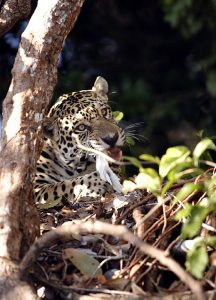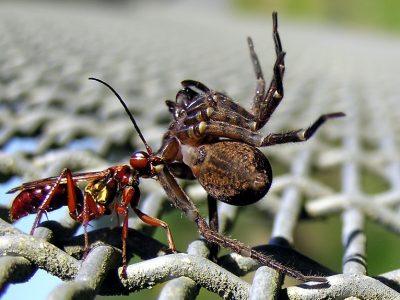Predator Prey Relationship Definition
The predator prey relationship consists of the interactions between two species and their consequent effects on each other. In the predator prey relationship, one species is feeding on the other species. The prey species is the animal being fed on, and the predator is the animal being fed. The predator prey relationship develops over time as many generations of each species interact. In doing so, they affect the success and survival of each other’s species. The process of evolution selects for adaptations which increase the fitness of each population. Scientists studying population dynamics, or changes in populations over time, have noticed that predator prey relationships greatly affect the populations of each species, and that because of the predator prey relationship, these population fluctuations are linked.
Predator Prey Relationship and Population Dynamics
In some predator prey relationship examples, the predator really only has one prey item. In these scenarios, it is easy to see how the predator prey relationship affects the population dynamics of each species. A simple example is the predator prey relationship between the lynx and the snowshoe hare. The hare forms a large staple in the lynx diet. Without the hare, the lynx would starve. However, as the lynx eats the hare, or many hares, it can reproduce. Thus, the lynx population expands. With more lynx hunting, the hare population rapidly declines. Look at the graph below.
The blue shows the population of lynx, while the red shows the population of hares. At the start of the graph, the lynx population was very high, which the hare population was relatively low. As the lynx started to migrate away, or die off, the hare population rebounded. Since 1845, this 10 year pattern has continued to repeat itself, with a lynx die off coming right after the hare die off. The predator prey relationship between the hare and the lynx helps drive this pattern. However, if you average out the peaks of the population, both populations would hold stable or show only a slight increase or decrease over time.
Remember also that the hare also has a predator prey relationship with the organisms it feeds on, which happen to be plants. As the hares explode, they eat more than the vegetation can support, and they are driven into starvation. That, plus their predator prey relationship with the lynx, makes for very volatile shifts in population.
Predator Prey Relationship and Evolution
As these populations continue to reproduce over time, the actions of natural selection can also change the species to make them better predators, or more defensive prey. Either way, this adaptation changes the entire predator prey dynamic. If one species cannot then adapt an appropriate defense, they may go extinct. In this way, the predator prey relationship often forms an “evolutionary arms race”, in which eat species rapidly evolves to counter the other.
While numerous examples have been observed of the evolution of traits via the predator prey relationship, some of the most interesting examples occur when the relationship is suspended. In tests on guppies, scientist have shown that a large, colorful spot is a sexually selected trait. Male guppies with brightly colored spots are preferred by females. However, predators can easily spot these colors, and eat the brightest colored males.
In streams where predators are not present, the males become brightly colored. Sexual selection rapidly evolves the males to be brightly colored, and their novelty and brightness drive their evolutionary success. In streams with predators, the males that succeed do so not necessarily because they were the most attractive, but because they lived the longest. The predator prey relationship in this case overpowered the pressure of sexual selection. It is a good example of how the predator prey relationship can greatly influence the path of evolution.
Examples of Predator Prey Relationship
Conventional Predator
Typically, a species has more than one predator prey relationship. Consider a jaguar for example. The jaguar is a solitary predator, preferring to hunt and live alone. The jaguar is a predator of many different animals, from wild hogs to caiman. With each of these species, it maintains a predator prey relationship. However, the jaguar is also a prey item for certain species. Baby jaguars stay with their mothers for a year or more before being able to fully protect themselves. Anacondas, large birds, and other felines are just some of the perils in store for a young jaguar.
The jaguar, like the one above, represents conventional predator. It hunts, kills, and eats other organisms. While jaguars are solitary predators, there are also social predators, which hunt in groups. These include species like wolves, orcas, and lions. The differences in these social structures represent the different evolutionary niches that the species have carved out, as well as the past predator prey relationships which shaped the animals as they are today.
Nonconventional Predators
Besides the conventional predators, many organisms fit the definition of predator outside of the typical boundaries. Scavengers, as a type of predator, have a predator prey relationship with each of the species that they feed on. For instance, a scavenger like a vulture is affected when the population of water buffalo falls. With less buffalo, the lions die off and make less kills, and then the vulture itself is affected. While this may be a lopsided predator prey relationship because the vulture doesn’t directly kill the buffalo, it is still affected by the population of buffalo. Luckily for vultures, they scavenge many species and aren’t reliant only on the buffalo population. This is not true for all scavengers.
Other nonconventional predators include parasites, which feed off of a host organism, but do not necessarily kill it. While the predator may be much smaller than the prey, they still have a relationship. The predator prey relationship between deer and ticks, for example, is very similar to the predator prey relationship between the lynx and hare. As the deer die off, the ticks have less to feed on, especially ticks which specialize on deer. The decline is caused in part by the ticks themselves, which add a parasitic load to the deer, and transfer disease within the population. The ticks will then reduce in numbers, allowing the deer to flourish.
Almost 10% of all known insects show a special form of parasitism. These parasitoids, as they are known, have developed a special predator prey relationship in which they lay their eggs inside of another species. The larva hatch, and eat their way out as the host slowly dies. While the adult is not consuming the other species directly, the larvae do. Below is a picture of a parasitoid wasp, carrying a tarantula it has paralyzed. The wasp will lay eggs in the living tarantula, which will hatch and devour it from the inside.
Plants as Prey and Predators
Plants are often overlooked as both prey and predators because they seem indifferent to the actions around them. However, many experiments and observations have shown that plants are active participants in the relationship. A stunning example is that of plant communication in response to predators. It has been shown that certain species of plants have evolved a specific defense to overgrazing. After moderate grazing levels have been surpassed, and the plant is in danger, it will begin releasing the hormone gas ethylene into the air. Other plants receive this hormone signal, and begin producing toxic substances in their leaves. Animals which feed on these plants become sick and die. In this way, an evolutionary battle and predator prey relationship has been evolving between plants and herbivores since they first coexisted.
Further, plants can be direct predators, and evolve complex predator prey relationship characteristics from that side as well. Consider the Venus Fly Trap, pictured below. This plant has developed directly as a predator of many flying insects. The plant not only has special hairs on the leaves which can sense the motion of insects and large spines to entrap them, but they also actively secrete substances to attract the insects. Other plants have developed different forms of insect traps, and they provide the plants with extra nutrients. This predator prey relationship is not much different than a snake waiting for a mouse to cross its path.
Quiz
References
- Blumstein, D. T., & Fernandez-Juricic, E. (2010). A Primer of Conservation Behavior. Sunderland: Sinauer Associates, Inc. Publishers.
- Feldhamer, G. A., Drickamer, L. C., Vessey, S. H., Merritt, J. F., & Krajewski, C. (2007). Mammology: Adaptation, Diversity, Ecology (3rd ed.). Baltimore: The Johns Hopkins University Press.
- Kaiser, M. J., Attrill, M. J., Jennings, S., Thomas, D. N., Barnes, D. K., Brierley, A. S., & Hiddink, J. G. (2011). Marine Ecology: Processes, Systems, and Impacts. New York: Oxford University Press.




